RV Battery Care and Maintenance
Understanding and Maintaining Your RV's Batteries
Article Date: May, 2011
Article and Photography by Mark Quasius
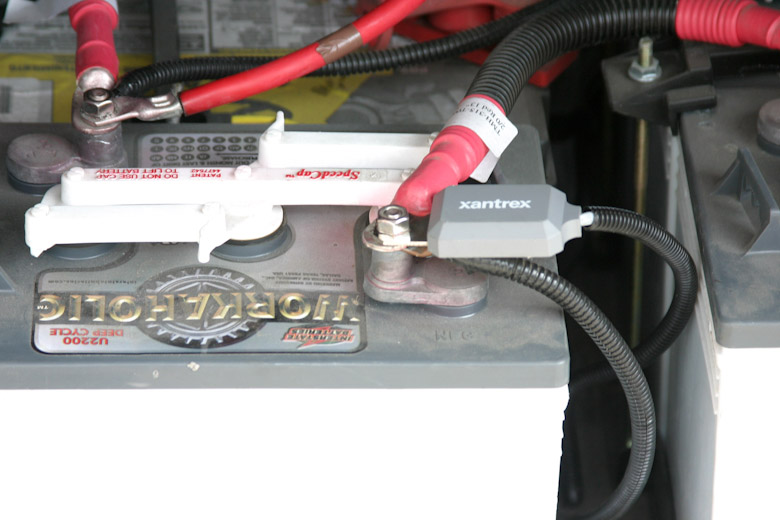
Batteries are one of the most important items in an RV. Without batteries you won't be able to power your
lights, water pump, fans, or other 12-volt devices. When dry camping they can be used to power an inverter to provide 120-volt AC
power. Yet they are one of the most least understood items by most RVers. Batteries live in a tough environment and can be a source
of aggravation and maintenance. We'll attempt to describe how batteries work, how to maintain them properly, and how to extend
their life span.
A Storage Chamber
|
A battery is really nothing more than a storage chamber. You fill it up, just like a fresh water tank, and
then gradually use its contents. Except it's electricity, rather than water. Batteries function by way of a chemical reaction. The
electrolyte inside the battery, which is basically sulfuric acid, reacts with the lead plates inside the battery to produce power
by transferring electrons from the electrolyte to the battery plates. In the process of giving up these electrons, the electrolyte
undergoes a chemical process that transfers sulphur to the battery plates and turns the electrolyte into water. When you recharge
the battery, the sulphur recombines with the electrolyte, changing it from its water state back to acid again.
|
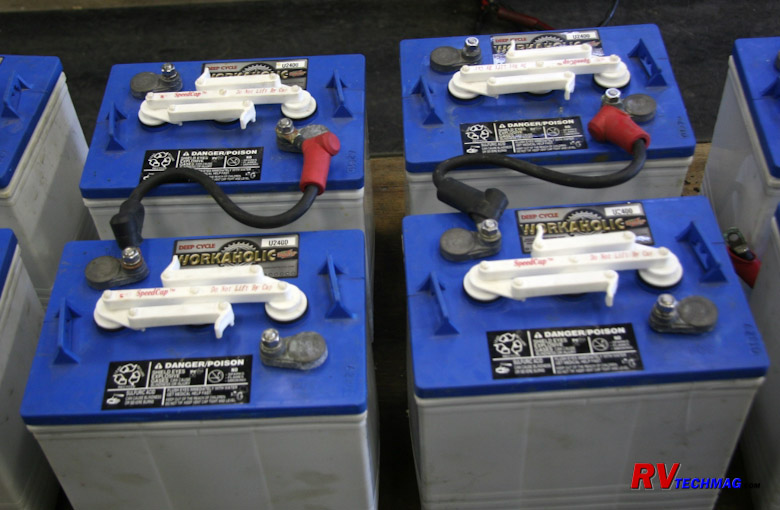
Six-volt batteries are typically found as a four battery array with series-parallel connections.
|
There are two general classifications of batteries: Starting batteries are what you will find on your vehicle.
They are capable of passing a temporary large current to crank a starter motor, then slowly recharge over time. Deep cycle batteries
are designed to provide smaller current discharge rates, but over a much longer period of time and are what you will find in your RV.
Life Cycles
Batteries are rated in life cycles. You can fully discharge a battery a given amount of times and then fully
recharge it, quite likely in the 50 to 80 cycles range depending on the battery. After that it will have exceeded its service life and
will no longer perform the work it was intended to do. If you do not discharge the battery fully it will last much longer. This is
graded on a curve, so discharging a battery to 50-percent charge level won't double your life. It'll more likely quadruple the life.
|
If you use even less of the battery it'll last even longer because the life chart is exponential as you
reduce the amount of discharge. For this reason it's best practice to never discharge a battery below 40 percent of its charge
level. If you exceed that the voltage will be much lower and won't provide much power plus you really stress that battery. To
determine exactly where your battery is refer to the voltage drop chart in this story. Note that these voltages are what you will
read when the batteries are connected in your RV. A battery that is disconnected from the system and has been at rest for a few
hours will have slightly higher readings.
|
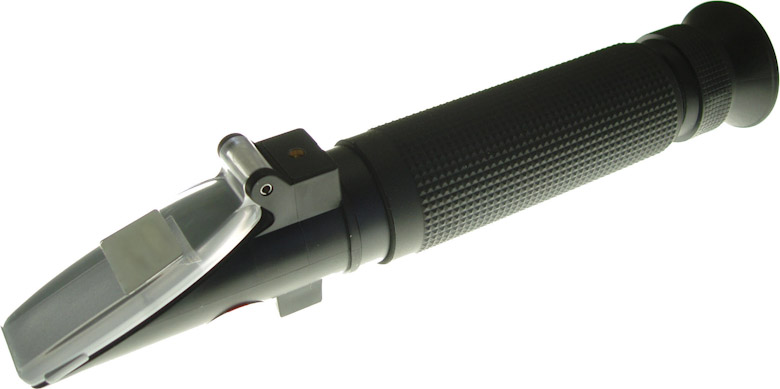
A battery monitor kit, such as the BMK from Magnum Energy, will monitor all current in and out of the battery and
provide accurate information as to your battery's state of charge.
|
Flooded batteries do require maintenance. When the batteries are recharged the sulfate recombines with the
electrolyte. If the charge continues after the battery is charged out-gassing will occur when the electrolyte boils. This produces
explosive hydrogen gas and acidic vapors that will escape the vent caps on the batteries. The acidic gasses will corrode the battery
terminal connections as well as hold-down bolts or anything else in the battery compartment. For this reason it's important that
flooded batteries always be placed in a vented compartment to prevent the buildup of explosive hydrogen gasses.
Out-Gassing
When out-gassing occurs the amount of electrolyte will decrease. At this point it will be necessary to add
some water to the battery to top of the electrolyte level. Be sure to use distilled water or else you may be reducing the ability of
the battery to conduct electricity as the minerals in the water attach themselves to the battery plates. If the electrolyte level gets
beneath the top of the battery plates your battery's life will be reduced. Do not add additional electrolyte to the battery. Only
add distilled water.
|
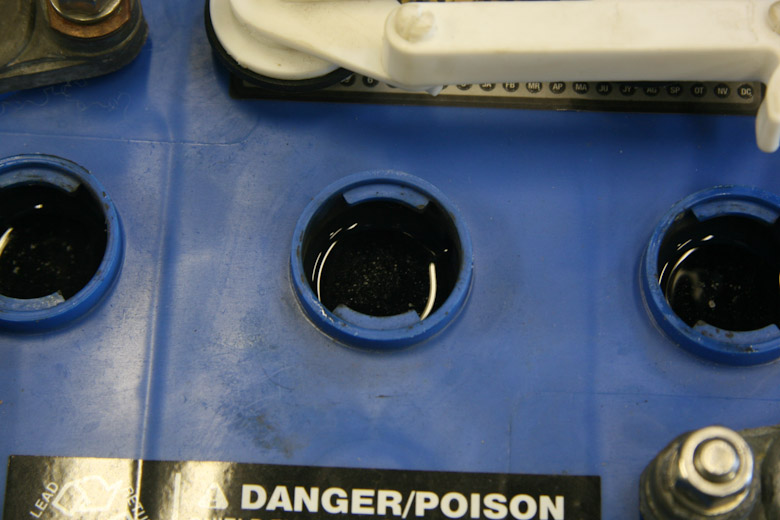
Maintaining correct water level in the battery is critical to battery longevity.
|
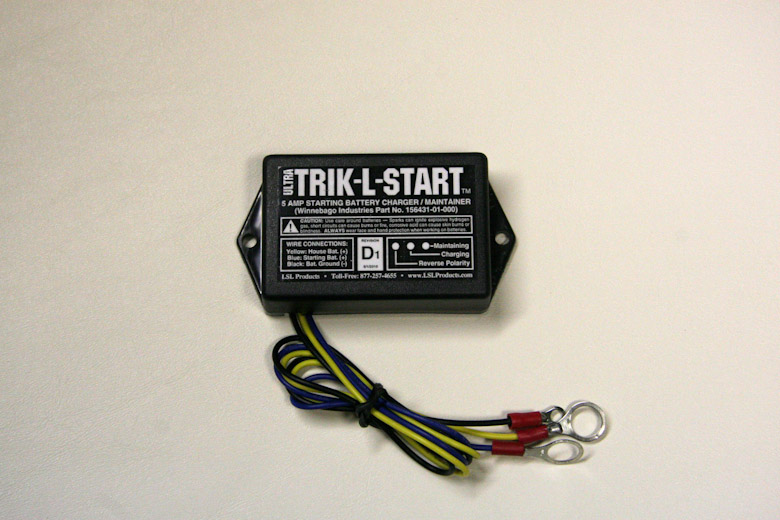
The Trik-L-Start helps motorized RVs maintain chassis battery charges when plugged into shore power.
|
Out-gassing occurs whenever the battery receives more voltage than it needs. Converters or inverter/chargers
typically handles the battery charging needs. Modern battery chargers utilize a three-stage battery charging system. The initial charge
mode is known as the Bulk Charge mode and restores the most power into the battery by producing constant current until it reaches a preset
voltage. Once the preset voltage is reached the charger goes into Absorption Mode and the voltage is held while the current flow
gradually tapers. Finally, the charger kicks into Float Mode in order to maintain the charge level without over-volting the battery. If
your battery charger is properly calibrated the odds are good that you will need to add very little, if any, water during normal use. If
you find that you are constantly adding water be sure to have your charger tested to see if it is supplying excessive voltage and damaging
your batteries.
The Battery Bank
Earlier we mentioned the need to never draw down your batteries beneath the 40 percent level. If you need to use that
much power from your RV it would be in your best interest to increase the size of your battery bank. Adding additional batteries is the
easiest way to add available amp-hours to your system, which will allow you to keep a higher level of charge in the batteries. Multiple
batteries can be connected in two ways, depending on whether you are using 12-volt batteries or 6-volt batteries. Your RV's electrical
system needs 12 volts to operate. If you have multiple 12-volt batteries you can connect them all in a parallel configuration. That
connects all positive terminals together and all negative terminals together.
Many RVs come with the 6-volt golf cart style batteries. These batteries are very robust and offer long life and
lots of power per battery. However, two 6 volts need to be connected in series in order to provide 12 volts. If you have four batteries
you'll need to create two series paired sets and then tie those sets together to achieve a 12-volt array.
Advancements in Technology
One of the more popular advancements in battery technology is Absorbed Glass Mat, commonly known as AGM batteries.
Your typical flooded battery consists of lead battery plates submerged in an electrolyte solution. They outgas hydrogen and corrosive gasses
when charged so you need to check the water level regularly and will have to deal with keeping the battery terminal connections clean from
corrosion salts. An AGM battery places its electrolyte in fiberglass mats that surround the battery plates. There is no liquid electrolyte
in the battery and the battery chambers are not truly vented, although they are valve regulated to allow for heat expansion. Because of
this there is no negligible out-gassing to be concerned with, therefore they do not need to be placed in a vented compartment. You'll never
have to check or add water because there isn't any and corroded battery terminals and mounting hardware area thing of the past. They can be
placed in any position so if you need to do a barrel roll with your RV nothing will leak out of the battery.
|
AGM batteries also have less internal resistance so they recharge faster than flooded batteries. You can also
run an AGM battery faster because the voltage falloff curve is flatter than on a flooded battery. The end result is that you can get
more runtime hours out of an AGM battery than an equally rated flooded battery because you can go a bit longer until you reach that
11.9-volt level. Suppliers such as Optima and Concorde Lifeline are the leaders in this field. The only real drawback to AGM batteries
is that they do cost more.
|
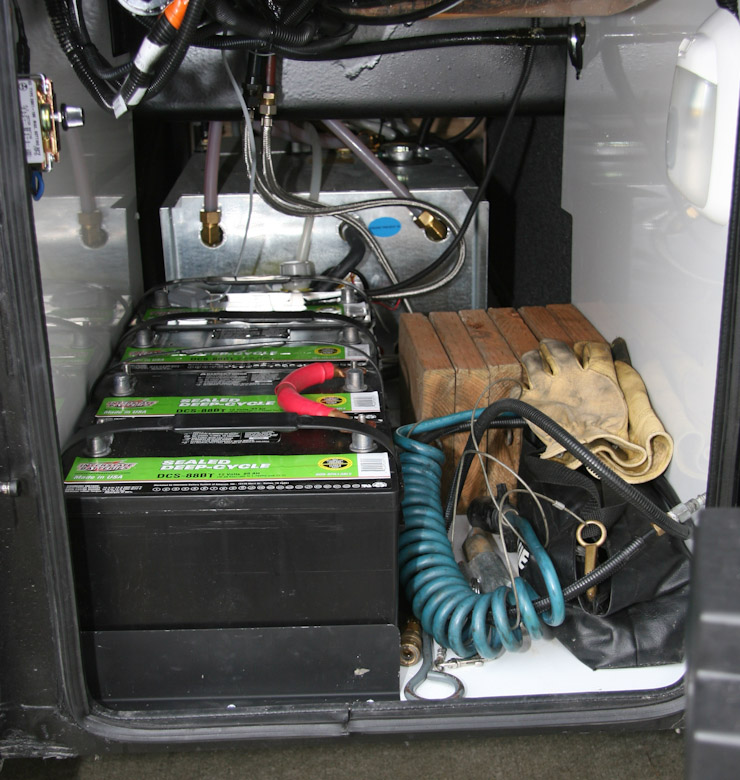
Because AGM batteries do not outgas like flooded batteries, they can be located in areas where flooded batteries cannot
be placed.
|
Voltmeter Testing
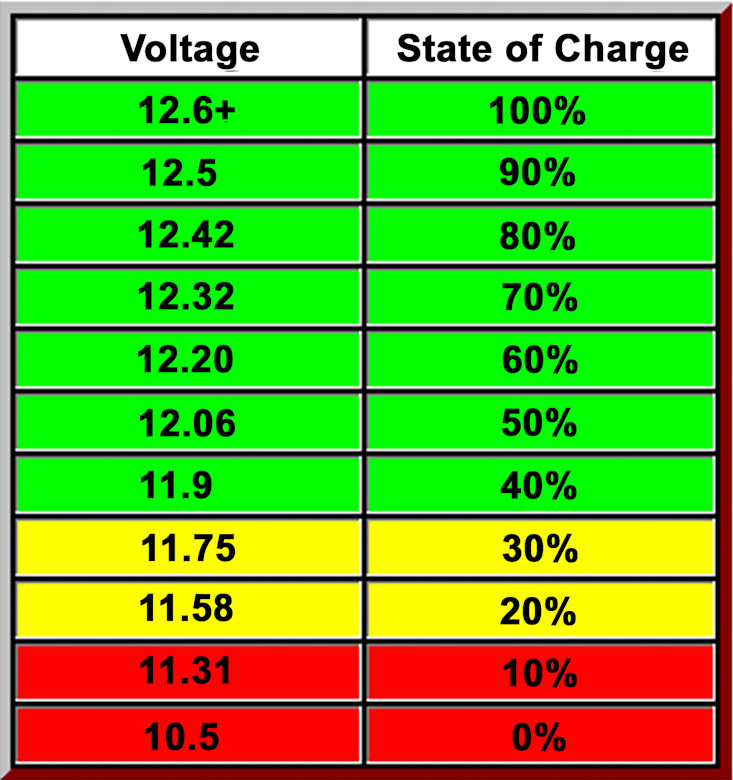
When flooded batteries just aren't doing the job any more it's time to perform some tests on your system. The first
test is the voltmeter test. If your batteries are fully charged you should be able to see 12.6 volts at each battery. Now, testing voltage
will not tell you if the battery is any good. It will only tell you if it is charged. It has no bearing on the ability of the battery to
pass the rated number of amps when demanded of it. However, your batteries do need to be fully charged when testing so this is the first
step. Once you have the batteries fully charged disconnect any loads from them and stop the charger. A battery that has just been charged
will have a surface voltage of 13.2 volts or more. This is a false voltage so let the batteries rest for a while to allow the surface
voltage to dissipate. The voltage should stabilize around 12.6 volts. If you cannot achieve 12.6 volts then it will be necessary to
proceed to the next step and test each battery.
Specific Gravity
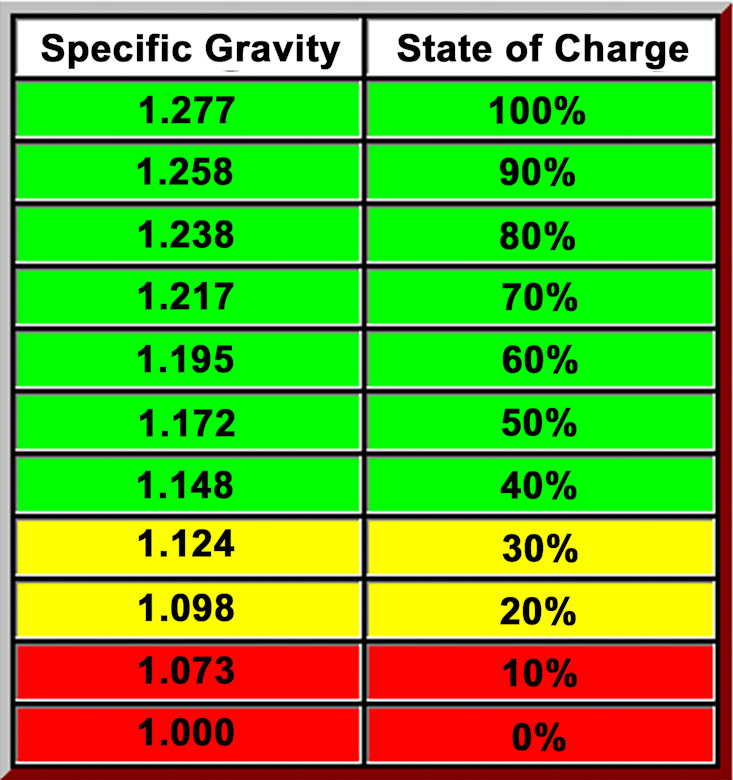
The next step is to see what each battery looks like. When battery electrolyte is fully charged its specific
gravity increases. When it's discharged the specific gravity lowers because it's basically water instead of acid. You can use a hydrometer
to test the specific gravity, but hydrometers are pretty much old school. Refractometers are much more accurate and do not require
temperature compensation. Plus a refractometer can be used to test antifreeze as well as battery electrolyte so it's a handy tool for
any RVer to own.
Every cell in a battery needs to be up to snuff or else the battery will not work, very much like a weak or broken
link in a tow chain. Remove each battery cap and take a small sample of electrolyte with your hydrometer or refractometer. Refer to the
chart on this page to see the state of that cell. If the battery is perfectly charged the specific gravity should be around 1.277. The
main thing to check for is that all of the cells are fairly even. If you have one dead cell the battery won't perform because it'll be
like a tow chain with a broken link. Similarly, if you have two 6-volt batteries in series, neither battery will be able to pass current
with that one bad cell in the chain.
Load Testing
|
Once you have determined that the batteries are fully charged and that each cell is within tolerance the next
step is to perform a load test. Load tests are done with a unit such as a carbon pile tester. A carbon pile tester is a dead load that
can be varied by turning a knob. An ammeter and voltmeter are supplied to monitor battery performance. A typical test consists of
adjusting the control until the ammeter reads three times the rated amp-hrs of the battery. Hold this for a few seconds and monitor
the voltmeter. If the battery voltage drops into the red zone your battery is no longer capable of performing at it's rated capacity.
|

Carbon pile load tester are ideal for checking the ability of a battery to output power. Prices for testers like these range
from as low as $40 to several hundred dollars, depending on features.
|
At this point you may need to replace your batteries, but there is one last trick you can try to recover them.
Battery plates become sulfated over time and the sulfur no longer recombines with the electrolyte when recharged. At this point you can
try to equalize your batteries to see if you can restore some life back into them. Equalizing involves applying a higher voltage current
to the batteries to boil the electrolyte and hopefully cook off any sulfate that has attached itself to the battery plates. Most modern
converters and inverter/chargers can handle equalizing functions. Be sure to refer to your owner's manual for specific instructions.
When equalizing, it will be necessary to disconnect any RV loads from the batteries to prevent any damage from the
higher voltage used during the equalization process. Many manufacturers recommend equalizing flooded batteries annually to prevent them from
getting too far gone. Note that under normal conditions AGM batteries are not equalized.
If you treat your batteries right you should be able to get the maximum lifetime out of them. With proper maintenance
and use you should be able to enjoy many hours of trouble free RVing.
Source
Optima Batteries
(303) 340-7400
www.optimabatteries.com
Interstate Batteries
(866) 842-5368
www.interstatebatteries.com
Concorde Lifeline Batteries
(626) 969-6886
www.lifelinebatteries.com
Trik-L-Start
(877) 257-4655
www.lslproducts.com
Return to Home Page
If you enjoyed this article be sure to recommend RVtechMag.com to your friends, like us on Facebook or Twitter
or subscribe to our RSS feed.



|













